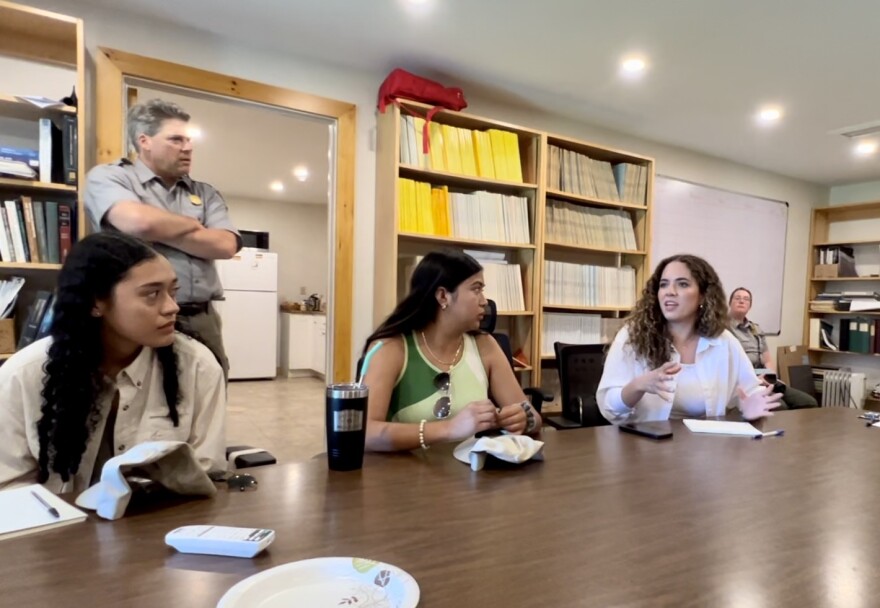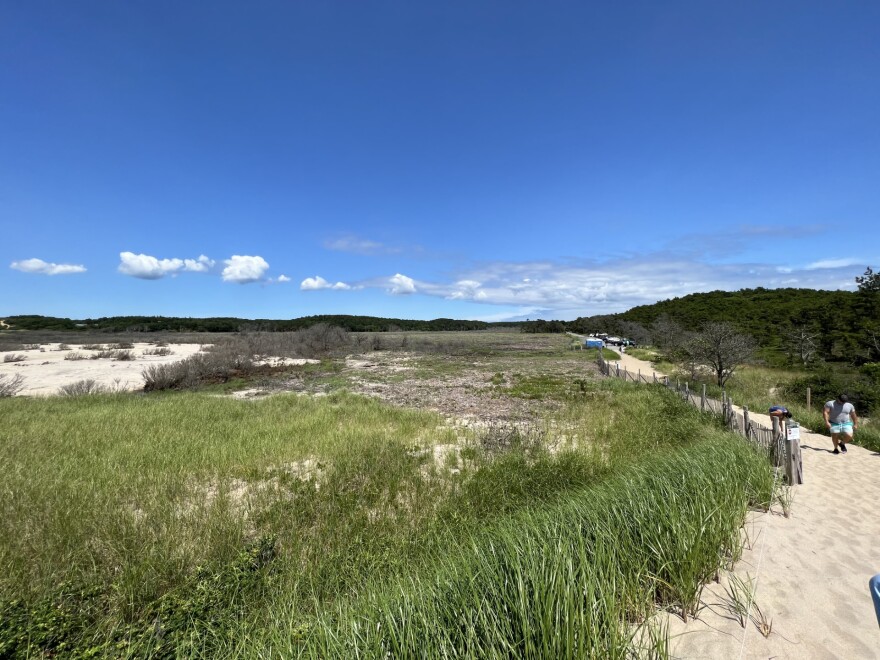At the edge of East Harbor in North Truro, 21-year-old Valeria Aguilar is reaching out to hold a horseshoe crab for the first time.
She’s one of four college women visiting Cape Cod from the Lake Pátzcuaro area, four hours west of Mexico City.
They’re gathered around Aquatic Ecologist Sophia Fox, of the Cape Cod National Seashore.
Fox hands Aguilar the wet crab, and she gasps quietly when it gives her a start moving its tail.
“Just be careful of the tail and your face,” Fox says. She explains that crabs are related to spiders — they’re arachnids.
“Araña,” one of the students says, using the Spanish word for spider. “Do they just live in saltwater?”
“Yes.”
The four students — Aguilar, Alejandra Garcia, Yolanda Peñaloza, and Ireri Servín — traveled to the Cape earlier this month to learn about the massive restoration project on the Herring River in Wellfleet. They hoped to see how Cape Codders gathered community support — and how to inspire similar work on a heavily polluted lake back home.
East Harbor is not part of the Herring River restoration the students traveled 3,000 miles to see. The East Harbor project is smaller, but it’s farther along.
Fox said it gives the students a glimpse of how a species can return even with modest changes to the water system.
“This is an area where we've been finding them thriving — we're finding baby crabs,” she said. “And so it's a very positive story of a restoration where everything has recovered into a functioning system, which is what you hope for.”
The students’ visit was a leadership-development trip through a summer camp where they’re graduating the internship program and joining the summer staff.
Each year, the camp centers on an issue of community concern, and this year, it’s the badly degraded Lake Pátzcuaro, a body of water that covers more square miles than Massachusetts’ Quabbin Reservoir.
A member of the camp steering committee has friends on Cape Cod. That’s how the restoration of the Herring River became the foundation of a cultural exchange.

While they were here, they got plenty of support from Seashore science chief Geoffrey Sanders and his staff, plus the Friends of the Herring River and the town of Wellfleet.
They learned how Massachusetts’ largest-ever estuary repair took many people, working together for decades, to plan and fund the work.
In a conversation with Seashore staff, the students talked about the problems of Lake Pátzcuaro and their goals for the future.
Peñaloza, 20, who is studying medicine, said healing Lake Pátzcuaro requires community organizing.
“We have four municipalities around the lake,” she said. “The sewage and the garbage goes to the lake. … So we want to know how to organize the four municipalities to work under one umbrella.”
Aguilar, a business administration student, said the lake is also compromised by agricultural chemicals from the growing of avocados in the Lake Pátzcuaro basin.
“People have cut down many of the last forests in the basin in order to plant avocados, which … need a lot of water and a lot of toxic chemicals,” she said. “And when it rains, the runoff sends all these chemicals into the lake.”
Later in the day, the students visited Duck Harbor with Seashore staff. The low-lying land behind a bayside beach in Wellfleet is connected to the upper reaches of the Herring River, so it’s part of the project to restore tidal flow.
As they looked out over the place where trees have died and salt marsh plants are returning, Restoration Ecologist Tim Smith told the students that Duck Harbor is also being inundated from the bay side by sea-level rise.

“These plants — everything that’s green, just short, little stubby plants — they can handle being flooded every day, twice a day, by salt water,” he said.
The study trip, organized by the Campamento de la Paz, or Peace Camp, caught the attention of Linda Bennett from the international affairs office of the National Park Service.
She decided it was important enough to meet the students on the Cape.
“I thought it was such a valuable program they were going to do here, to learn from the park, present their case, develop some solutions, and go back into their community in Mexico and actually apply them,” she said.
And she said the Seashore benefits, too, by hearing about shared phenomena, such as invasive species, and making international connections.
When the students returned home, they planned to meet with the mayor of Pátzcuaro to share what they’ve learned.
They’re taking a stand, not only for their own futures, but also for civic activism to heal the lake they love.






